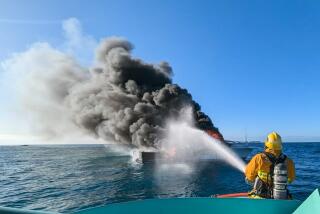John Windle; Participant in Catalina History Since 1910
- Share via
John W. Windle, Avalon’s longest-term resident who from age 6 considered Santa Catalina his own special island, has died at 95.
Windle, whose life paralleled the island’s modern development for 89 years, died Wednesday at his home in Avalon, his daughter, Sue Bray, said Sunday.
“Johnnie” Windle moved to Avalon in April of 1910 after his father, Ernest, established a business there. The town, which now boasts a year-round population of 3,500, then had only 285 residents.
“When I got here, I was 6 1/2. I thought everything on Catalina belonged to me,” Windle related to authors William White and Steven Tice for their 1997 book “Santa Catalina Island: Its Magic, People & History.”
“I came down onto the Pleasure Pier to where they had their boat stand and I got in a rowboat,” Windle continued. “The guy says ‘Whataya doin?’ I said, ‘I’m going for a ride.’ He told me the boats were for paying customers--rental only. I got bawled out.”
With an uncanny recall of names, dates and happenings, Windle lived to be a walking oral history of Catalina. He wrote the spiel for bus drivers to voice on the Starlite Tour of Avalon, and could recite it until his death.
A recording of Windle’s narrative on his town will be played, his daughter said, at his memorial service next Monday at 3 p.m. in Catalina’s fabled Casino.
As a boy, Windle set type for his father’s Catalina Islander newspaper.
He was there when Glenn L. Martin, who later founded Martin-Marietta Corp., landed his Flying Seaplane after the first trans-channel flight from Newport Beach to Avalon. The flight, less than nine years after the Wright Brothers proved man could fly, was then the longest ever made over water.
Enamored of the “hydro-aeroplanes,” Windle later learned to fly from barnstormer H.H. Holloway, who had flown in World War I under the command of Eddie Rickenbacker.
Ironically, in 1978, Windle was a passenger in a twin-engine Grumman “Goose,” which for years ferried travelers across the channel, when the little seaplane slammed into the water and flipped over. Rescued by boat, he suffered only minor injuries.
As a boy, Windle also witnessed a massive fire that wiped out much of commercial Avalon in 1915. According to White and Tice’s book, the blaze began in the Hotel Metropole near the Windle home and razed 10 wood hotels and several other buildings.
“I can still hear the glass falling out of the windows as the buildings collapsed,” Windle said eight decades later.
Windle was 16 when William Wrigley Jr. bought the island. The youth started working for Wrigley’s Santa Catalina Island Co. as a messenger boy and remembered meeting one of Wrigley’s guests, President Calvin Coolidge. Windle spent 31 years with the company, moving on to truck driver and then superintendent of transportation.
He was with Wrigley in 1927 when the chewing gum magnate chose the site for what became the Casino dance pavilion.
The night of its grand opening on May 29, 1929, Windle and a few other men inched under the dance floor in a crawl space to conduct their own unscientific measure of the building’s stability. They took turns holding a thin steel rod between their teeth and resting it against any steel beams they could reach under the dance floor to gauge the vibration. Their determination: “solid as a rock.”
Windle had already conducted his own test by driving his Model T Ford through outer doors on the Casino’s ground level and up the series of ramps to park in the middle of the dance floor.
As a second career, Windle in middle age patrolled the island as constable under the auspices of the Los Angeles County Sheriff’s Department. He kept tabs on the rural mountains for 23 years.
Windle is survived by his wife, Jeanette; two sons, John W. Windle Jr., of Huntington Beach, and Robert Ochsner, of Yucaipa, Calif.; a daughter, Sue Bray, of Avalon, nine grandchildren and 15 great-grandchildren.
The family has asked that any memorial contributions be sent to the Catalina Island Museum in Avalon.
More to Read
Sign up for The Wild
We’ll help you find the best places to hike, bike and run, as well as the perfect silent spots for meditation and yoga.
You may occasionally receive promotional content from the Los Angeles Times.






